#children's book reviews
Explore tagged Tumblr posts
Text
Book Review: Gryphons Don’t Celebrate Shavuot (2023)

https://rebeccacrunden.com/2023/04/28/book-review-gryphons-dont-celebrate-shavuot-2023/
#shavuot#judaism#gryphons#book review#children's books#children's book reviews#book reviews#jewish books#jewish authors#jewish#indie book spotlight
4 notes
·
View notes
Text




Train Your Brain! Brain Teasers, my first of four puzzle books is out today! 🥳🍾🥳🍾
It's got over 100 fun puzzles for ages 8-10 all illustrated by yours truly!
You can order it on Amazon now, and you should totally request it at your local library!
#talkies#me tag#children's books#children's illustration#puzzle book#puzzle books#middle grade books#illustration#PLEASE CONSIDER BUYING AND LEAVING A NICE REVIEW THANK YOUUUU IVE WORKED HARD ON THIS#arcturus publishing
369 notes
·
View notes
Text

“Sometimes people, like tales, begin where they do not belong.” Nadya is a Russian orphan, born with only one arm, adopted by an American couple more interested in ‘doing good’ than in raising a real child. Her only solace in her new home is watching turtles in a local pond. But one day, glimpsing a sort-of door in the grasses, she falls into the water—and wakes a Drowned Girl, in a world where water is air and turtles are lifelong companions.
Seanan McGuire’s Wayward Children series really never misses. Adrift in Currents Clean and Air is all the more precious for what readers of the series know will always come: a door will bring her in, but she’ll also be cast out. (It isn’t necessary to dive back into Beneath the Sugar Sky, where Nadya first made her appearance, before reading, but it will enhance how poignant the story really is.) I loved this waterworld; some fantasy worlds are twisty and difficult to follow, but Belyyreka isn’t (or maybe it just calls to me, a water lover, a girl who loves the waves). It’s built cleanly and seamlessly.
The issues in it are well thought-out and done with careful, sincere grace. Nadya’s adopted parents treat her like a thing, a possession to carry with them, to shape and carve into a perfect, American child. Shortly before her door takes her away, they order her a prosthetic without asking or explaining, expecting her to be automatically grateful, when she has never been anything but capable and content with her one arm.
All around, another superb addition to the Wayward Children stack. I’m already impatient for the next!
#wayward children#seanan mcguire#adrift in currents clean and clear#book blog#wayward children series#my book reviews
46 notes
·
View notes
Text
Alterhuman Review: No I Am a Wolf
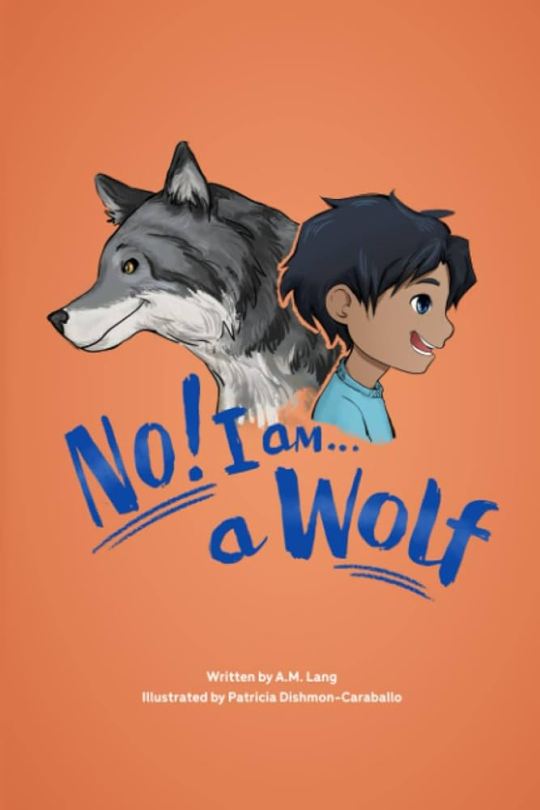
Author: A.M. Lang
Illustrator: Patricia Dishmon-Caraballo
Publication Date: January 2022
Official Book summary:
George can’t be bothered with mundane human tasks; he is a wolf. Wolves and kids have many differences but they also have some things in common. Embrace your child’s wild side with this cute story plus animal facts.
So, we've been aware of this children's book for about half a year now. Upon first seeing it, we feared this might be a Johnny The Walrus by Matt Walsh situation. (That is, a thinly-veiled transphobic dig at the existence of transgender people, that accidentally also hits the alterhuman community due to its content, wrapped in the guise of a children's picture book.) But after gathering up courage hope, we finally bought a copy not to long ago. This book is NOT anything like Johnny The Walrus by Matt Walsh. No transphobia here and this book is also accidentally very alterhuman affirming as well.
The book consists of 21 illustrations with text. With each turn of the page the reader sees the left page showing George (the book's character) as a boy having to do ordinary human boy things (brush teeth, put on clothing, bathing, etc.) with text telling George to do said task, while the right page shows a wolf in George's place along with an affirmation "No, I am a Wolf" (usually, several scenes are instead in the positive, "Yes, I am a Wolf") along with additional text saying what a wolf would or would not do. The book ends with George being told: “Good night, my little wolf.”
While the author likely meant to create a cute children’s book showing a child imagining himself as an animal in the way that is common and normal among children, the book also happens to be very alterhuman. As someone who lives with a full phantom body, the illustration of a wolf stuck in situations doing everyday human things, like brushing your teeth, certainly felt very “yeah it be like that.” So, in summary, cute children’s book that is accidentally very alterhuman and is not transphobic at all! Yay!
204 notes
·
View notes
Text





The Hundred Acre Kingdom
out now
https://www.barnesandnoble.com/w/the-hundred-acre-kingdom-hasani-walker/1146510245?ean=9780979835599
#hasani#hasani walker#disney#story#illustration#disneyland#winnie the pooh#hundred acre kingdom#hundred acre woods#piglet#pooh bear#tigger#eeyore#new books#barnes and noble#book reviews#books and reading#book review#reading#books#book community#childrens books#nostalgia#reimagined#fantasy#high fantasy
47 notes
·
View notes
Text
Mislaid in Parts Half-Known (Wayward Children, #9)by Seanan McGuire | ARC Review
Goodreads | Amazon US | B&N | Blackwell’s | Bookshop 1.) Every Heart a Doorway ★★★★★2.) Down Among the Sticks and Bones ★★★★★3.) Beneath the Sugar Sky ★★★★4.) In an Absent Dream ★★★★★5.) Come Tumbling Down ★★★6.) Across the Green Grass Fields ★★★★7.) Where the Drowned Girls Go ★★★8.) Lost in the Moment and Found ★★★★★ ARC provided by Tor – thank you so much !! “The door wasn’t there because…

View On WordPress
#ARC#ARC Review#Book Blog#Book Blogger#Book Review#Book Reviewer#meltotheany#Mislaid in Parts Half-Known#novella#Review#Seanan McGuire#Wayward Children
222 notes
·
View notes
Text
Picture book: "Workitu's Passover" by Zahava Goshen & Ben Hagai (2024-03-30)
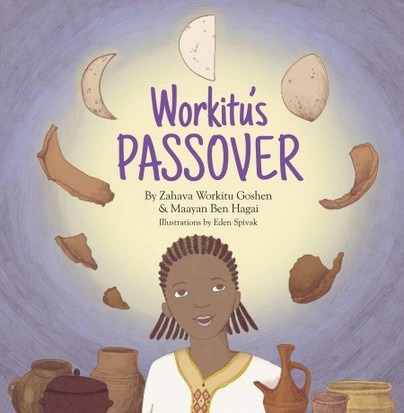
Ethiopia has one of the longest continuously practicing Jewish communities in the world, dating back to the 4th century CE. Being so old and so distant from other major Jewish communities, Ethiopian Jews have their own particular traditions, and one is explored here.
The day before Passover, Workitu and her sister must smash all of their family's crockery, including Workitu's favorite cup. Workitu is distraught over her loss, until she learns that all the clay is softened and worked into the plates, cups, and other tools that will be used for the following year, allowing her to keep her cup, but in a new form.
This story is less about religion, and more about emotions, family, and tradition. It is a celebration of unique heritage, and one that we really don't see much in picture books.
Oh, but why, oh why, is this book being released in the US on the LAST DAY of Passover!? I want to read this to my nephews! But our big family Seder is on night 2! I can only hope that someone manages to push through an early ebook publication, but it looks grim.
If you're going to have final-night seder with your family (or if you're in the UK, where this book already released), pick this up, definitely. And I shall envy you.
#book#book review#review#picture book#judaism#ethiopia#beta israel#ethiopian jews#passover#children's literature#netgalley#arc
98 notes
·
View notes
Text




I finished The Hobbit recently and I wanted to talk about it.
Full disclosure If you haven't read the book yourself, watched the movies, or seen any memes I would like to warn you moving forward in this review will contain spoilers
My rating: 3.75 ★★★★
Summary:
A high fantasy story set in an intriguing and expansive world. Throughout the story you mainly follow a character that's from a race called hobbits, and a bunch of dwarves. They get themselves into a number of predicaments throughout their adventure and we (the readers) get to witness their shenanigans, as well as meet a few interesting characters.
In the book your introduced the MC Bilbo Baggins, Gandalf, Thorin, Bombur, Fili, Kili, Bofur, Bifur, Oin, Gloin, Dwalin, Balin, Dori, Nori, and Ori. We also encounter other iconic characters such as Thranduil, Elrond, Beorn, Gollum, and Dain to name a few.
I can appreciate that this was revolutionary for the time and as you read this you can see how it influenced the fantasy genre. The writing style is very much a product of its time, so if your not used to early 20th century writing or if you don't like it, it might be difficult to get into this book. Aside from the style the way the story is written was difficult for me to read not in the sense that the writing was complicated it was just hard to immerse myself that might be a me issue, I'll revisit this if I decid to do a re-read. The characters don't get much development aside from Bilbo the MC. To a certain degree I would forget about some characters were there because they rarely did anything or weren't mentioned as frequently as others. So it was hard initially to get attached to characters even within the main cast. I will say that Fili, Kili, Bombur, and Thorin stood out to me the most out of the 13 dwarves. Gandalf was kind of just there which I find amusing it was quite literally just a side quest for him. Some of the other characters were decent, we don't really get to know much about them, but that makes sense since the book focuses on the Bilbo's perspective so it makes sense that readers would be kept in the dark.
I will also say that the world building is brilliant, it feels flesshed out despite it being a small book it was described in a way that still made it believeable and intriguing after the first 80 pages or so. I think it also helped that the characters kept moving from place to place. So that we got to several different locations in this world and the different species and some of the cultures in this world.
Some critics I have for this book is that the characters get into difficult situations and get out of them pretty conveniently. For instance Bilbo just randomly coming accross the ring was a good idea in a sense but it was too easy that he just passed out and when he woke up randomly came across it. Another example would be whenever they were captured by an antagonist (i.e. the trolls and goblins) and then last minute Gandalf would miraculously show up and save them. I get that he's extremely talented in magic and insanely powerful so much so he's a living MacGuffin but still it just felt to easy, and made me question why he couldn't do anything sooner. Don't get me started on when Smaug got super mad at them and instead of attacking Bilbo and company he decided to fly off and destroy Esgaroth. the only time I felt like the stake we're relatively high was when the humans we're trying to fend of Smaug, but that just made me more mad at the fact that Bilbo and company got off pretty much Scott free. I feel that it kind of lowered the stakes for me and so I didn't really feel concerned for the characters. Although it is a children's book so it can be expected. Another thing that bothered me was the songs, there were numerous songs throughout the book. I usually don't mind songs but they sounded the same, the lyrical style and rhyming scheme was the same despite the fact that some of these songs were coming from several characters from various different races and cultures. It just seems unlikely that they would be that similar. I understand that there can be similarities between different cultures especially when they are close to one another but there would also be some slight differences and there simply isn't. Also the book is written to be a translation. It seems strange that the songs were translated to rhyme in the first place. The likelyness of something rhyming from one language to another is slim, and if the song was translated to rhyme then would that not bastardize the original language of the song? It just really irked me.
However in a less critical note there is also some pretty good symbolism in the book some of the things that I noticed and saw from other reviews was:
Orcrist and Glamdring being symbols of heroism
The ring symbolizes power something that can be useful and handy in many situations but has its drawbacks
Thorin gets dragon sickness which can symbolize greed obviously and how quickly it can consume you and destroy your relationships in addition to yourself.
Also Thorin being buried with the arkenstone is nice not sure if it counts as symbolism. I think it could symbolize the heart of the mountain/people being returned to its rightful place
I would also like to add it might be the movies and memes that has corrupted my perception of Thorin and Bilbo's relationship I think it's kind of romantic that Thorin waited to die until after he saw Bilbo one last time. Also it might just be wishful thinking to support this claim Bilbo and Thorin hadn't known each other that long considering their species' lifespans. Not to mention Thorin's reaction to when he thought he had been betrayed. I know his mind was corrupted because of the dragon sickness and he was being protective of the gold and the mountains because of its significance to him and his people but even still he had a visceral reaction and seemed incredibly hurt. Either he was projecting his pent up emotions about the situation at Bilbo or he felt something for Bilbo those are the only two logical explanations to me. If you have other theories feel free to share.
TRIGGER WARNING ⚠️
Mention of Antisemitism -
Another thing I want to point out is the antisemitism. I didn't notice initially and I was confused because I had seen people talk about. In my copy around page 192 there was a strange and unnecessary comment about how the dwarves really are, and it did consist of common antisemitic characteristics. Although I wouldn't really associate the dwarves with Jewish people, but I can see why someone might see some similarities I suppose. I don't think it was a deliberate choice on Tolkien's part, I think it was probably an subconscious decision. Unfortunately in the case of a lot of popular books especially with classics this is a pretty common issue. Although from what I've heard he did apologize and was more cautious in LOTR. Which is something, I guess
#book review#the hobbit#books and reading#tolkien#booklr#book recommendations#yapping#professional yapper#lotr#hobbiton#aesthetic#book#magic#fantasy#hobbitcore#literature#children's books#thoughts#complaining#thorin oakenshield#thorin x bilbo#gandalf#elrond#thranduil#tolkien elves#rant post
25 notes
·
View notes
Note
The message from The Child is part of why I don't get some folks when they say kids books should never include real world topics cause they won't get it or something any kid can relate to feeling left out. That being said the postcard you made was adorable 🤗
Thank you! And that's true! I love hearing from kids (which I cherish since most of the time I hear from parents or adult reviewers) and I'm always so delightfully happy when they're able to relate and discuss kids books like Lunar Boy in a really in depth way. Even if it's through their kids-speak, you can tell they've made a connection to the story.
Kids are just so much smarter with stories than adults like to believe!
#askjesncin#i heard from a book reviewer how their kid yoinked their copy of Lunar Boy the minute it arrived and loved it so much he read it twice#the children's picture books i read have such a core memory in my brain as an illustrator. aah#making kids books is such a privilege i never take for granted
26 notes
·
View notes
Text
2024 Book Review #34 – Children of Memory by Adrian Tchaikovsky
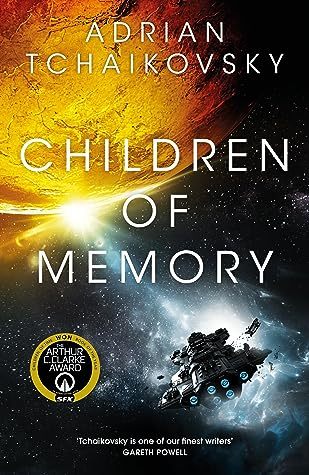
Overview
I have had this on my list for long enough for my request that the local library get a copy actually result in me getting my hands on it. It’s the third instalment (the last? I’m not sure – the ending here felt like far less of a natural conclusion than the ending to either of the previous two) of what is for my money some of the absolute best space opera (maybe even just science fiction writ large) of the last decade. I actually opened it with a real sense of trepidation; Children of Ruin had ended on an optimistic, open-ended note, with the creation of an interstellar and inter species society that was both deeply aspirational and incredibly alien. I wasn’t sure how a book from their perspective would even work. Thankfully, my fears were basically misplaced – there’s definitely a drift in tone and focus from where the series started, but the thematic heart’s still there, and this was overall a joy to read.
Synopsis
Following the end of Children of Ruin, we have a nomadic society of uplifted spiders and squids, Humans (the capitalization signifies infection by an engineered retrovirus to help with empathy and accepting/valuing the Other), the formerly all-consuming alien microbal parasites of Nod (who have agreed to only assimilate the identities of those who expressly consent to the process), and various instances of Avranda Kern (millennia old upload of a meglomaniacal mad scientist who is by a quirk of history now the OS all computers run on). After making tentative Second Contact with a half-terraformed world now inhabited by a civilization of debatably-sentient crows, an exploration ship takes on a pair of them as ambassadors before finding their way to way what seems to be a struggling but holding on colony founded by one of the last arkships of refugees to escape the ruins of Old Earth. .
Intercut with this is the narrative of that arkship arriving, very much the worse for wear after two thousand years and change hurtling through the void with its crew and cargo in cryo. The world is hardly what they hoped for – only ever half-terraformed, breathable atmosphere and some basic engineered microbal life, but entirely lacking any sort of biosphere – but it’s not like they have another option. They make the best of it they can, using what working technology they have to bootstrap a basic ecosystem of pigs and trees, a few species of bugs and fungi, enough to farm and build with. And the core crew holds out hope that the faint trace of a strange signal buried in the hills near their colony might lead to something more.
Intercut with that is the story of Liff, a young girl in the colony as things take a turn for the worse. That’s when things start to get weird.
Xenophilia
The best way for me to get across the central theme of this whole series is ‘more star trek than star trek’ (or at least, than any star trek produced since I’ve come of age). It believes is absolutely nothing so strongly as it believes in the pure and perfect virtue of curiosity, that the point of existence is to discover, and to share what you have discovered with those around you. It is an oft-repeated point that the overwhelming majority of the universe is cold and empty, and anything different is worth seeking out and treasuring for its own sake – that every shred of diversity is the cosmos is a wonder in its own right.
Which is the entire purpose our protagonist’s civilization has set themselves – the distributed fleet of pathological scientists and novelty-seekers, leaving behind teeming cities and orbital habitats for a life seeking the mysteries of the universe with tiny circles of peers. It’s very Starfleet, in its most idealistic and elevator-pitch form.
And even beyond them, curiosity, discovery and exploration are treated as basically heroic wherever they’re found – Captain Holt and the Enkidu might have been doomed, but they’re still presented as deeply and wholly admirable for trying.
It goes beyond that, too. This is one of vanishingly few space opera settings I can think of with a cast full of distinct and dissimilar species, where none of them are orcs. Or dragons, for that matter. No matter how monstrous and horrifying a species seems – spiders the size of your head, the mad remnant of an ancient demiurge, all-consuming and replicating alien parasites – the answer is diplomacy, outreach, communication. Both sequels in the series have begun with a civilization formed through the total (though not seamless) integration of alien societies from the last book into a greater whole. The parasites from Children of Ruin best exemplify this, I think – convinced that consuming and assimilating everything it can reach will result in nothing but a universe of itself, compared to walking through the world with a soft touch and appreciating all the different dynamics that can develop through so many myriad perspectives. And now one of them is basically the book’s main protagonist (and very guilty about all the nonconsensually-eating-people thing).
Whereas in Memory it’s not exactly subtle that the intolerance and violence against social deviants is presented as basically a symptom of material scarcity and desperation. When Landfall is doing well, the little band of infiltrators – strange, nonverbal artist, discomfortingly informative schoolteacher, standoffish and thoroughly gender nonconforming woodswoman – are affectionately tolerated and appreciated for what they can do. When the harvests are bad and the forests are rotting – well who even needs abstract art or history lessons to begin with? They’re lashed out at, used as just one of a growing set of scapegoats, and when things are dire enough, again and again, they end up on the noose. Intolerance is a self-harming reflex, a wounded animal lashing out because it can neither understand nor change the actual source of its pain. Again, Star Trek but moreso.
The ‘moreso’ does a lot of work in this comparison, to be fair. The series shares Star Trek’s deep love of science just like it shares its pathological liberalism – it’s just consistent about it. The crew explorers are casually transhuman (transarachnid, transcephlopod, etc) - immortal and physically enhanced, capable of sharing and downloading both memories and skills, visibly aging or carrying scars only as a fashion statement. It is treated as a casual fact of life that letting an experiment progress might mean going into cold sleep for decades or centuries, if there is no better way for a group of six on a small ship to while away the time while they wait. Technology has conquered scarcity on anything like a personal scale, and the explorers take full advantage.
Which is probably downstream of the books not being particularly caught up on ‘humanity’. I mean, humans are there – are very important! - but to the extent they’re the axis the universe turns upon, it’s only the ghosts of the old empire. Modern humans are just one part of interstellar civilization, and not even its most numerous or prominent. Humans have a unique way of thinking (as does everyone else) but no monopoly on heroic drive or virtue.
Curious Corvids
Each book in the series feels marketed around a different uplifted animal arising from the ruins of humanity’s imperial glory and galaxy-spanning hubris. This is not wrong, but it definitely becomes less right as the series progresses.
Children of Time is about the spiders. There’s humans too, sure, but I’ve yet to see a single person who read for the Gilgamesh plotline. By wordcount and thematic focus and just what makes it an interesting book, it is about the evolution of Portid intelligence and civilization across the millennia. The real protagonist of the novel is the species.
Children of Ruin is still kind of about the uplifting of the Squids. Senkovi’s efforts and relationship with them gets a decent amount of focus, as does the development of their civilization after the terraformers’ death. They just share top billing with the alien aliens, and rather than just being the climax of the story Second Contact is the real meat of the entire plot.
In Children of Ruin the introduction of the corvids almost feels like a publisher mandate – their history and backstory is basically brushed over in the prologue and one interlude, Second Contact basically a triviality. It’s not that they’re not important to the book or its themes, or that they’re not interesting (in both cases they very much are!), but they feel like a b-plot. Supporting what the book is about, not defining it.
Which to be clear, is from a writing perspective almost certainly the correct choice – ‘Children of Time but with a different species’ would still be fascinating, but it really doesn’t cohere as a continuing and linked series. I just think you could have dug some more meat out of the abbreviated history given there. What fanfic is for, I suppose.
It’s a funny sort of distinction that unlike the others, the corvids aren’t technically uplifts – the considered opinion of the series is that while spiders and squids would require millenia of nanite-assisted directed evolution to develop anything that looks like human-level sapience, in the right environment crows would just Do That (admittedly with the addition of alien radiation scrambling DNA and increasing mutation rate by an order of magnitude or two).
The other trend with the different uplift species as the series has gone on is that with each book they become neurologically and psychologically weird. The spiders had Understandings and a bunch of predator- and cannibal-instincts, but they’re still each an individual intelligence. The squids are a central brain and a bunch of semi-autonomous limbs which are only barely on speaking terms with the conscious mind. And now the crows are not individually intelligent at all – they think and live in pairs, one observing and recalling, the other analyzing and inferring, actual intelligence appearing only in the dialogue and interaction between the two. Which makes chapters from their POV very entertaining, at least.
Sentience and Identity
The book’s very interested in both – it’s probably the most central and explicit theme of the entire thing. Our crows, having given the matter thorough and careful reflection, eventually decided that they weren’t sentient at all (that nothing is, really) – or at least, that’s the series of sounds they make when asked. Our other main characters include:
an alien parasite which has assimilated a copy of a woman’s consciousness and now imitates her so well she often forgets she’s anything else
a copy of a sliver of an instance of an upload of an ancient terraformer, who for a nontrivial period of time was running on hard that was mostly ant colony
an extremely detailed simulation of someone who could have but never did exist
(arguably) the simulation they are running on.
The book comes down pretty solidly on a ‘if it quacks like a duck’ model of personhood – and cheats a bit in terms of giving most of the above POV chapters and obvious internal monologues – but the question of who counts as sentience and as a person, and of what ‘sentient’ and ‘person’ even mean – are ones that various characters spend a lot of time and angst on.
The answer the book arrives at isn’t exactly a surprise – see above, more star trek than star trek – but it’s still an interesting angle to look at everyone from.
Genre Ambiguity
The book is clearly, self-evidently science fiction, but Tchaikovsky still has a lot of fun playing around with some fantasy tropes and imagery in it. Liff is an adolescent who dearly loves her book of ancient fairy-tales, and so our view of Landfall and the world beyond it, which means basically her entire plotline is narrated with a fairy-tale sensibility. In fairness, Kern and the crows do an excellent job accidentally seeming like a witch and her familiars. Landfall’s whole deal seeming a lot more like a fairy curse than anything from the inside doesn’t hurt, either.
While it’s science fiction, Memory is definitely softer science fiction than the previous books in the series. In general, human- and human-descended technology all at least has the convincing appearance of rigour and plausibility, while anything alien falls solidly into the real of space magic plot devices. So we get elaborate narration on the exact details of how the crew of the Enkidu bootstrap a functional ecology around Landfalll before their high technology begins giving out, but the simulator buried in the hills Just Works. Which as neat a way to do the division as any, really, but there’s a real shift in tone from Time where just about everything feels like it’s from the first category. I mean, they have fTL now!
Conclusion
This isn’t really a book I’d call groundbreaking – Children of Time has much more of a claim to novelty in both subject and presentation – but it’s one that I think solidly achieves everything it tries to? The writing’s good, the characters all cohere, the themes are explored intelligently. Plus, Kern is probably one of my favourite characters of all time.
So y’know if you don’t have major issues with spiders, multiple POVs and unclear timelines, or existential angst, would solidly recommend.
43 notes
·
View notes
Text

🍁 Autumn Story by Jill Barklem (Brambly Hedge #3)
Rating: ⭐️⭐️⭐️⭐️/5
It’s Harvest Time at Brambly Hedge and Primrose Woodmouse goes on an unexpected adventure.
My friend Mable ( @the-forest-library ) has posted about Brambly Hedge for some time and I finally jumped to read it- starting with the third book, but the most seasonal one as it is Autumn right now. This was such a delightful story to read, and the illustrations made up a large portion of my delight. As I was writing my review in my book journal I wanted to compare Barklem’s art to Beatrix Potter, but I quickly backtracked because Jill Barklem’s art is all her own. It’s detailed, soft, and so immersive. Only she could’ve done it. I definitely recommend this book.
#godzilla reads#brambly hedge#autumn story#autumn books#book review#childrens books#jill barklem#reading#book blog#fall books
31 notes
·
View notes
Text
The Book, "Children of Time," by Adrian Tchaikovsky is great because it accuses you, mercilessly of being human and thinking in human-centric ways. It is an incredible piece of fiction, and well worth the read.
19 notes
·
View notes
Text
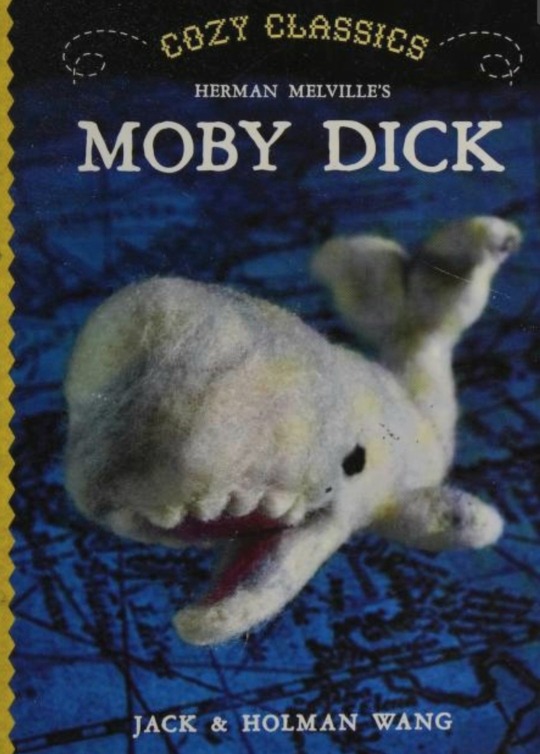
Developmental psychology scholar read Cozy Classics' Moby-Dick! Here are the thougts.
For those who haven't heard of the Cozy Classics, they are a series of board book adaptions of great classics such as Oliver Twist, The Wonderful Wizard of Oz, and Jane Eyre, created by Jack and Holman Wang and intended for young children. What makes these books stand out, however, is that they come with a most delightful needle felted twist!
Each book contains 12 illustrations, consisting of photographs depicting scenes from the original story and featuring needle felted characters and props.
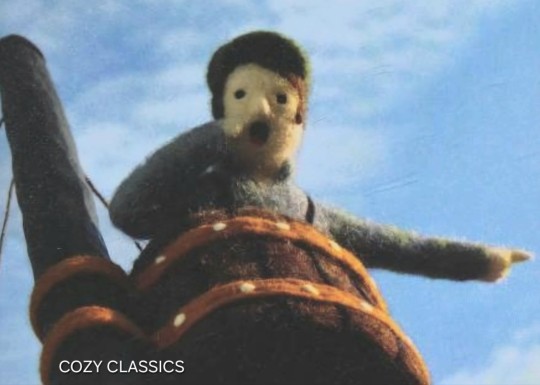
In addition to this, 12 words related to the story are printed in-between the illustrations; "sailor", "leg", "boat", "find"...
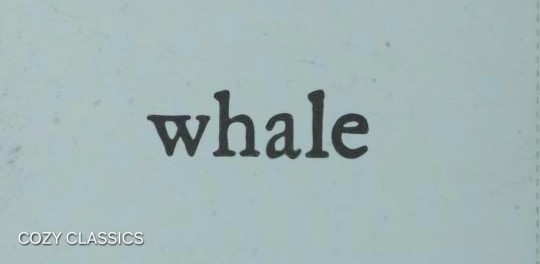
...et cetera. Guess Moby-Dick gets a bonus word though, since "Pequod" is ever so neatly embroidered on the ship's fluffy name plate.
I have to say that this whole concept is nothing short of genius. Not only are the little ones presented with the classics fitting their own level of perception, but the materials shown in the pictures are all familiar ones to them sensory-wise, thus much more relatable than conventional illustrations.
As for the words, they are fitting 1-2 syllable ones, but their meaning - at least in this case - are somewhat unsual. I'm telling you, one doesn't find educational toddler literature containing "smash", "sink", and "mad" together all that often. The choice of words in combination with the pictures also works in an almost insidious fashion in that they will now be forever planted in the lil' one's brain and for the rest of their life they will recognize that peg legged dude with anger issues.
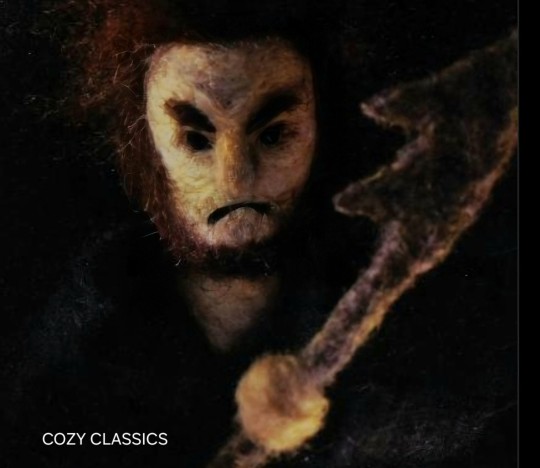
The book manages to capture the essence of the original quite well and what truly surprised me was how the creators did not hold back on the dark stuff. Ahab looks like something that definately will come crawling out from under your bed at night for a maniacal stabbing session, Moby Dick turns the Pequod to splinters, and a heart broken Ishmael floats around on a coffin. Even the color scheme is moody and ominous. We approve! 👍

Even if you don't have a child nearby to brain wash, I highly recommend you check this book out - it's up for a free read on archive.org - for the sake of admiring the pieces of downright wool art.
So, there's the Cozy Classics Moby-Dick for ya. Now I have to go ponder whether I should add a request for a needle felted coffin in my death plan.

#moby dick#herman melville#literature#childrens books#classic literature#developmental psychology#captain ahab#ishmael#white whale#needle felt#cozy classics#book review#love it
27 notes
·
View notes
Text
Really liking the new Eidolon novel so far (50% read-live-review)!
Obviously - spoilers for "Eidolon - The Auric Hammer"!

Collins retcons quite a few things about the Lord Commander Primus - so Eidolon now joins ranks with Sanguinius' hair colour, Fulgrim's eyes or Lucius' first death.
In that case: Our beloved screamy guy is no longer a chemosian noble, but terran. And even joins the ranks of the famous 200! (muffled angry Fabius-noises in the background)
At first I had quite a few problems with it. As I had considerable difficulty engaging with the book in general, as it starts in a very cookie cutter way - the Third Legion gets its all too familiar glaze brushed over it (you know, like, "depravity" ...) and I had a few nasty flashbacks to the less talented writers who have had their way with Fulgrim's sons in the past.
But gradually Collins shakes off this stuffy mantle and finds a language of his own. Which, to my immense delight, reminds me a lot of Josh Reynolds! He's not quite ready to give the characters the degree of autonomy and depth that makes Reynolds' protagonists so interesting down to the last supporting role, but he's making great strides towards the dry melancholy and sarcastic tragedy that have made the Fabius books and the Fulgrim Primarch novel such a distinctive pleasure to read.
And honestly - he had me with this amusing nod to Tennyson!
‘Some weakling brother who yearned to follow the primarch, I imagine. There are countless of them. Lotus-eating fools who would have followed Julius into yet deeper madnesses. No use at all, unless you required someone to run at the enemy screaming of their own apotheosis. You were meat, once. Now you are just a figment.’
Marc Collins. Eidolon: The Auric Hammer
That's why I'm now embarking on the second half of the novel with renewed enthusiasm. In the constant hope that my favourite Astartes might now once again have an author who loves them as much as I do and who can do justice to their tragic grandeur.
"Courage!" he said, and pointed toward the land, "This mounting wave will roll us shoreward soon." In the afternoon they came unto a land In which it seemed always afternoon. All round the coast the languid air did swoon, Breathing like one that hath a weary dream. Full-faced above the valley stood the moon; And like a downward smoke, the slender stream Along the cliff to fall and pause and fall did seem.
#warhammer#horus heresy#emperor's children#Eidolon#Eidolon - The Auric Hammer#Marc Collins#Black Library#Book Review
21 notes
·
View notes
Text
2024 was FILLED of milestones:
- I published my FIRST OWN children’s book📚
- I was part of THREE local art exhibitions
- November was my 1st network meeting with artists and authors
All while I worked on my next big project! ✏️
MORE things to come in 2025! ✨

#art#anthro#illustration#anthropomorphic#artwork#drawing#mouse#digital art#traditional art#rodent#art vs artist#year in review#children’s book#kidlitauthor#kidlitart#kidlitillustration
13 notes
·
View notes
Text
Paleolithic Media Catalogue
Hello everyone :) Short story first: When I began brainstorming for my prehistoric story, I started wondering what other prehistoric fiction there is out there. I was not familiar with it and have not seen much. That's when I started my grand literature review and began a search for what fiction exist out there. I wanted to know what kinds of stories are being made with this time period. What are the common themes or recurring ideas (I found lots of humans and dinosaurs works. And time travel). Since I've had a growing collection on my computer, I decided I should keep on enlarging it and put it online. It's nowhere near complete. I'll slowly keep accumulating the collection as I find more. I only have fiction books and comics right now. I still need to work on the film section.
You can access the blog here!
***
As for where I am in my reading, the one's I've finished reading are Earth's Children series (book 1-4. Dropped it afterwards lol. I made a post on with fanart) Dance of the Tiger and it's sequel Singletusk (They were good! I'll upload my review on the blog), and Sisters of the Wolf (It was ok!). I got my hands on The Inheritors and excited to start reading it. I REALLY want to read the Shiva trilogy, but I found no PDF online... and it's out of print :( There is certainly old copies on ebay. And I want to read Chronicles of Ancient Darkness. There seem to be lots of good books out there.
#For whomever might find it useful... I'm doing this#I actually found another huge catalogue by an awesome person called Stephen Trussel#However their site has not been updated since 2016#I've linked their site on my blog when referencing the ENG translation for 'paris before man'#I'll make a paragraph dedicated to that site too#This has gone beyond my initial literature review lol#But for someone writing in this genre.. I've got to get to know it well#Because If I do end up publishing it I KNOW for sure it will be set up against other prehistoric fiction#mainly earth's children series#LITERALLY every book I checked had people in the reviews comparing it to Auel's series. Like it's the blueprint of prehistoric fiction#Like it's 'The Lord of the Rings' of its' genre.#and since it's a graphic novel maybe it will be compared to other comics?? Which I haven't found a lot YET#Emmanuel Roudier's work looks SO GOOD#I say looks because it's in French and I can't read French#I'm tempted to try translating it with what little French I learnt from public school and actually learn French in the process#Mezolith is great but it's not a full story. Just small snippets/short stories#Same with Tiger Lung. It's great. Also very very short. I recommend both.#I have not read the mangas yet. I read the first few chapters of Grashros and it's 100% Shounen stuff so far lol
54 notes
·
View notes